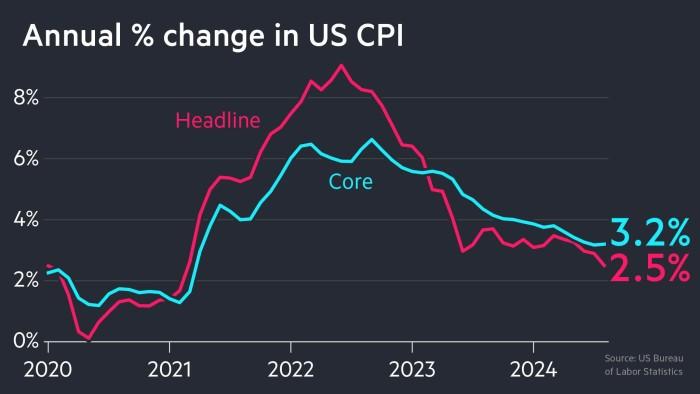Deng Tong, Jinse Finance
This week will become the "most data-rich week" in the United States. What major events are worth paying attention to in the next three days? What is the future trend of the crypto market?
I. Major Events Worth Noting in the Next Three Days
1. Federal Reserve Interest Rate Meeting
At 2:00 AM Beijing time on July 31, the Federal Reserve will announce its latest interest rate resolution, and Powell will hold a monetary policy press conference.
On July 28, local time, Trump stated that the Federal Reserve must cut interest rates. Trump said, "Even if rates are not cut, the United States is doing well, but it will be better after a rate cut". Federal Reserve Chairman Powell's term ends in May 2026. The Federal Reserve led by Powell is unwilling to lower the benchmark interest rate from the current target range of 4.25% to 4.50% to 1% as Trump requested, to reduce the federal government's borrowing costs. Trump is dissatisfied with this and has repeatedly threatened to make Powell "leave".
The "Fed mouthpiece" Nick Timiraos wrote in an article that Federal Reserve officials expect they will ultimately need to continue cutting rates, but they are not yet ready to do so on Wednesday. Their disagreement is about what evidence they first need to see and whether waiting for everything to become clear is a mistake. Officials are now split into three camps on whether to resume rate cuts. The focus will be on whether Powell will provide any hints of a September rate cut at the press conference, and whether his colleagues will begin laying the groundwork for a rate cut in the coming days and weeks.
[The translation continues in the same manner for the rest of the text, maintaining the specified translations for specific terms and preserving the original formatting.]The Hong Kong Monetary Authority (HKMA) issued the "Supervisory Guidelines for Licensed Stablecoin Issuers", "Guidelines on Anti-Money Laundering and Counter-Terrorist Financing (Applicable to Licensed Stablecoin Issuers)", and consultation conclusions for the stablecoin issuer regulatory system to be implemented from August 1, 2025, on July 29. The two sets of guidelines will be gazetted on August 1, 2025. The HKMA simultaneously released the "Summary of Stablecoin Issuer Licensing Regime and Application Procedures" and the "Summary of Transitional Provisions for Existing Stablecoin Issuers". The HKMA stated that no licenses have been issued to date. They encourage institutions interested in applying for licenses to contact the HKMA by August 31, 2025, to communicate regulatory expectations and provide appropriate feedback. Licensing will be an ongoing process, and if individual institutions believe they are fully prepared and wish to be considered early, they should submit an application to the HKMA by September 30, 2025.
Stablecoins are extremely hot in Hong Kong. HKMA Chief Executive Eddie Yue published an article titled "Stable and Far-Reaching Stablecoins" on July 23, cautioning against excessive hype and preventing financial risks. "We must prevent market and public opinion from over-hyping, and there are some phenomena worth our attention: first, over-conceptualization, but what is more worth our attention is the trend of bubble formation."
Everbright Securities released a research report stating that the global retail cross-border payment market size will reach $39.9 trillion in 2024. According to FXC Intelligence, this scale will increase to $64.5 trillion by 2032, with a compound annual growth rate of 6.2% from 2024 to 2032. In RMB cross-border clearing and multi-currency settlement businesses, third-party payment institutions have been deeply embedded in the payment ecosystem, playing a crucial role. It is expected that stablecoins will drive the global expansion of RMB cross-border payment infrastructure and diversification of application scenarios, with promising revenue growth for third-party payment companies. In the long term, compliant stablecoin development has broad prospects, helping to standardize the stablecoin market, enhance investor confidence, and promote market expansion.
4. US Q2 GDP Data to be Released
On July 30 local time, the US Q2 GDP data will be released.
Data released by the US Department of Commerce on Tuesday showed that the goods trade deficit in June narrowed by 10.8% from the previous month to $86 billion. The unadjusted data was lower than all economists' predictions in media surveys.
The latest US June goods trade data has prompted some economists to revise up their estimates for the US second-quarter GDP, which will be released on Wednesday. Analysts believe that the trade phenomenon that dragged down US GDP at the beginning of the year is expected to be basically reversed in the latest quarter.
According to the Atlanta Fed's real-time forecast, the GDP growth rate for Q2 2025 is 2.90% and 2.38%.
Goldman Sachs previously raised its Q2 GDP growth expectation from -0.3% to 2.4%, believing that the Q1 GDP data might have been underestimated.
Moody's Analytics predicts that the US full-year GDP will grow by 1.5% in 2025, but believes the Q2 data may be slightly higher, noting that the US economy will be in a "weak expansion" state.
If the US Q2 GDP data exceeds expectations, the economic improvement may boost investors' risk appetite, with some funds flowing into the crypto market.
5. Non-Farm Payrolls Data to be Released
The US non-farm payrolls data will be released local time on Friday.
The July non-farm report is expected to confirm that corporate hiring is becoming cautious. After the June education sector employment surge, new employment is expected to slow down, with the unemployment rate potentially rising slightly to 4.2%. The US government's June personal income and spending report is expected to show that the Fed's preferred core inflation indicator will slightly accelerate month-on-month, indicating that tariffs are gradually being passed on to consumers.
Citi analysts in their latest research report noted that if the US labor market shows signs of weakness, it could trigger a more dovish reassessment of Fed expectations, driving a new round of US dollar decline and causing funds to seek new investment channels, potentially increasing the attractiveness of cryptocurrencies. Citi expects July non-farm employment growth to slow to 100,000, with the unemployment rate potentially rising to 4.2%.
6. Tech Giants' Earnings Season
After-hours on Wednesday and Thursday local time, Microsoft, Meta, Apple, and Amazon will successively release their financial reports.
The four tech giants will release their financial reports on Wednesday and Thursday this week. The performance of companies with a total market capitalization of $11.3 trillion will be a key test for the S&P 500 index to continue its rally. According to media data, among the approximately one-third of S&P 500 index components that have already reported earnings, about 82% have exceeded profit expectations, potentially creating the best quarterly performance in nearly four years.
However, analysts have significantly lowered expectations in the past few months, mainly due to concerns about tariffs' impact on consumer spending and profit margins. Earnings forecasts for large tech companies have also been reduced. Data shows that the "Mag7" second-quarter earnings are expected to grow year-on-year by 16%, lower than the 19% predicted in late March. Meanwhile, the S&P 500 index's year-on-year earnings growth is expected to be 4.5%, also lower than the 7.5% predicted in March.
If the results are good, it may boost overall market sentiment, increase fund activity, and potentially lead to more funds flowing into the crypto market. If results fall short of expectations, market confidence may be hit, with increased risk-averse needs potentially leading to funds flowing to stable assets and out of the crypto market.
II. How Will the Future Crypto Market Develop?
Although the short-term market structure outlines a bullish recovery, the long-term pattern suggests that BTC's bullish momentum may be weakening. A Double Top pattern may appear near its historical high point, reflecting buyer fatigue. If it fails to break through the daily supply zone of $123,200, it will validate this bearish pattern, thereby hindering price discovery.
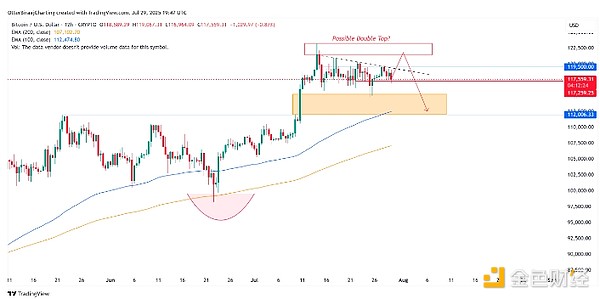
Bitcoin 12-hour chart. Source: Cointelegraph/TradingView
Bitcoin's daily Relative Strength Index has sharply dropped from 74.4 to 51.7, indicating spot market weakness, while daily trading volume has fallen to $8.6 billion. These two data points suggest that market participation is declining. Spot BTC ETF fund flows have also decreased by 80% from last week, dropping from $2.5 billion to $496 million, indicating that institutional investor interest is cooling.
Although futures open interest remains high at $45.6 billion, the increase in long-side funds suggests growing over-confidence. Additionally, 96.9% of the supply remains in profit, indicating a high likelihood of profit-taking.
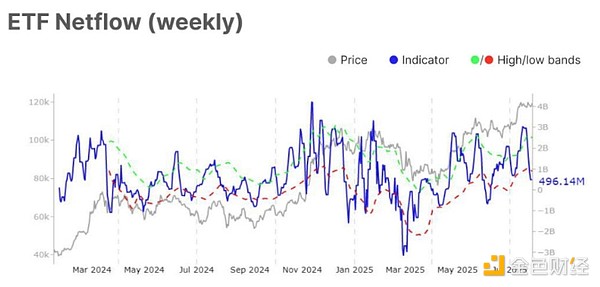
August's historical return rate further confirms this view. Over 60% of funds closed at a loss in August, with an average return of 2.56%, meaning the upcoming month will face seasonal headwinds. Combined with weakening on-chain activity, such as declining active addresses and transfer volumes, BTC price may retrace in the coming weeks.
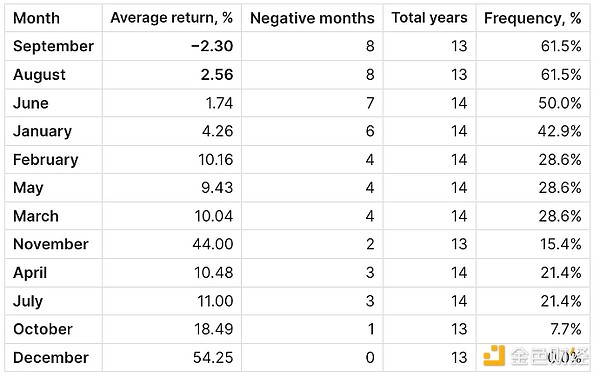
BTC historical monthly average returns. Source: Axel Adler Jr.
The latest research from on-chain analysis platform CryptoQuant suggests that the Stablecoin Supply Ratio (SSR) has been growing in sync with BTC/USD, which may indicate a lack of investable stablecoin liquidity or "dry powder".
Arab Chain believes: "The rise of this indicator suggests that the volume of stablecoins is low compared to Bitcoin trading volume. In other words, liquidity is weak, thus the market lacks the purchasing power to support Bitcoin. The increase in this indicator, along with Bitcoin's price rise, indicates that this increase is happening without new stablecoins entering at the same rate. The continued rise of this indicator may suggest that future buying momentum could weaken due to low liquidity." The market may be entering a "temporarily saturated" period. "The market is still partially supported by liquidity, but Bitcoin's continued rise requires a significant increase in stablecoin reserves in the coming days."
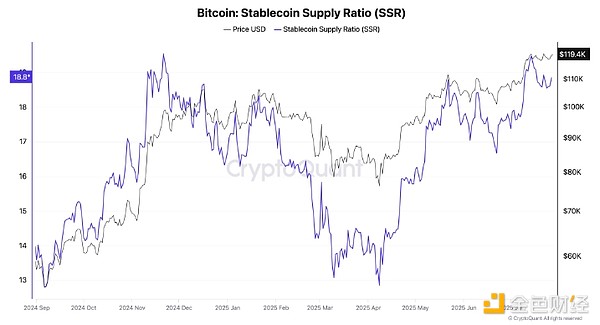
Bitcoin SSR and BTC/USD trend chart. Source: CryptoQuant
Trader Crypto Tony predicts: "If Bitcoin can tighten and maintain above $117,000, I believe we will soon set a new historical high."
Rekt Capital states: "Currently, BTC needs to avoid breaking through the bull flag top resistance level, otherwise the price will remain within the range."




